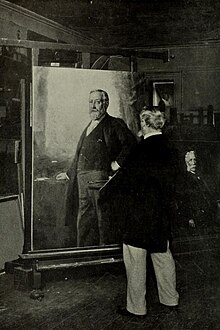Eastman Johnson
Jonathan Eastman Johnson (July 29, 1824 – April 5, 1906)[1] was an American painter and co-founder of the Metropolitan Museum of Art, New York City, with his name inscribed at its entrance.
(His younger brother Philip became a Commodore in the United States Navy and father of Vice Admiral Alfred Wilkinson Johnson.)
After his father's political patron, the Governor of Maine John Fairfield, entered the US Senate, the senior Johnson was appointed by US President James Polk in the late 1840s as Chief Clerk in the Bureau of Construction, Equipment, and Repair of the Navy Department.
[2] Although the young Johnson lived for a time in Boston, and studied in Europe, he used this home as his base until moving to New York City in the late 1850s.
[2] The young Johnson moved to Washington, D.C. at about age 20, supporting himself by making crayon portraits, including John Quincy Adams, and Dolly Madison, and likely helped by his father's political connections.
In January 1851, Johnson was accepted into the studio of Emanuel Gottlieb Leutze,[7][8] a German who had lived in the United States for a while before returning to Germany.
He ended his European travels in Paris, studying with the academic painter Thomas Couture in 1855 before returning to the United States that year due to the death of his mother.
He secured his reputation as an American artist that year with an exhibit at the National Academy of Design featuring his painting, Negro Life at the South (1859) or, as it was popularly called, Old Kentucky Home.
Echoes of Millet's The Gleaners can be seen in Johnson's The Cranberry Harvest, Island of Nantucket, although the emotional tone of the work is far different.
Portraits, Girl and Pets and The Boy Lincoln, make use of single light sources in a manner that is similar to the 17th-century Dutch Masters whom he had studied in The Hague in the 1850s.
Johnson's subject matter included portraits of the wealthy and influential, from the President of the United States, to literary figures, to unnamed individuals.
[14][15] Johnson left Wisconsin due to a widespread financial panic, which rendered his real estate investments there worthless.
[18] Negro Life at the South (1859), completed shortly before the Civil War began, is considered Johnson's masterpiece.
[12]) An adult black woman looks out an upstairs window as she steadies a small light-skinned child sitting on the partially collapsed roof.
[citation needed] These variations among "people of color" reflect African-American society of the Upper South, but also invite the viewer to contemplate the mixed racial ancestry of those portrayed.
[20][page needed] Both proponents and detractors of slavery perceived this painting as supporting their world views, because the Negroes seem cheerful enough, but their house is dilapidated.
Johnson places the slave family squarely in the center of the work, acting as agents of their own destiny.
[21] Curator Eleanor Harvey writes the painting "captures the moment when the full scope of the slavery question begins to loom.








